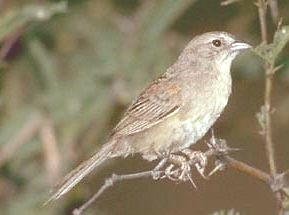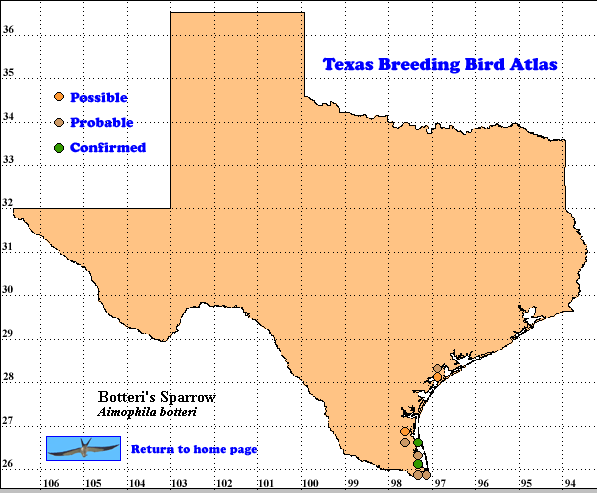Botteri’s Sparrow is an inconspicuous grassland sparrow, often acting more like a small rodent than a bird, difficult to identify visually and best found and identified by its “bouncing ball” song. Taxonomically it is a complex of as many as 9 subspecies, spread over disjunct ranges in Mexico and Central America with subspecies in northeast and northwest Mexico spreading into south Texas and southeast Arizona, and southwest New Mexico in the breeding season. The Texas population averages paler dorsally than birds in Arizona and New Mexico (Howell and Webb 1995, Webb and Bock 1996, Pyle 1997). Breeding seasons vary geographically with the Arizona population breeding from about July 10 to September 1 (Corman 2005). Data from the references cited above and the discussion in Am. Ornithol. Union (1998) strongly suggest much more information is needed before species or subspecies limits within Botteri’s Sparrow can be defined with confidence.
DISTRIBUTION. During the 1987-1992 field work of the TBBA project, volunteers found confirmed breeding evidence for Botteri’s Sparrows in latilomg-quads 26097-A4, B3, B4 and E4 (3). Probable breeding evidence was found in 25097-H2 and H4, 26097-A3 (3), C4 and E5 (3) and 28096-C8, with possible breeding in 26097-F6, G5 and G6 and 28097-B8
From Texas, breeding continues south along the coast of Tamaulipas (perhaps spottily), then south through much of mainland Mexico to the Yucatan Peninsula and then in scattered areas of northern Central America. Other races are found in northwest Mexico, southeast Arizona and extreme southwest New Mexico. Breeding populations in northern Mexico and the United States move southward in winter (Webb and Bock 1996).
SEASONAL OCCURRENCE. Botteri’s Sparrows are present in south Texas from late March to early October. They breed from early April to mid-July, based on egg dates from April 16 to June 16 (Oberholser 1974, Lockwood and Freeman 2004)
BREEDING HABITAT. In Texas Botteri’s Sparrows breed from near sea level to 10 m (40 ft) elevation in bunch grass habitats with scattered mesquite and huisache, generally within 33 km (20 mi) of the Gulf Coast (Oberholser 1974,). In Arizona 90% of breeding evidence was found in Sonoran Desert grasslands (Corman 2005). Further south habitats are more varied and breeding ranges extend to as high as 2500 m (8300 ft; Howell and Webb 1995). In Arizona nests were hidden on the ground in grass clumps with a side entrance sloping up to the nest. Construction takes <6 days to produce a cup of dried grasses and leaves, lined with animal hair (Webb and Bock 1996).
The female usually lays 3 (range 2-4) white, unmarked eggs. The nest and eggs are similar to those of Cassin’s Sparrow (A. cassinii). The female incubates the eggs for about 12 days and the nestlings fledge about 10 days after hatching and remain with their parents for another 17-25 days. In southeast Arizona only 1 of 24 nests was parasitized by a Brown-headed Cowbird (Molothrus ater; Harrison 1979, Webb and Bock 1996).
STATUS. The TBBA map indicates breeding further north than the map in Oberholser (1974) although total ranges are similar. Lockwood and Freeman (2004) consider Botteri’s Sparrow to be an uncommon to local summer resident on the southern coastal plain. Although upland populations have been extirpated by urban- expansion and intensive agriculture (cotton fields) the remaining populations on publicly and privately protected areas such as Laguna Atascosa National Wildlife Refuge and the King Ranch seem safe for now (Webb and Bock 1996). Text by Robert C. Tweit (2007)
Corman, T. E. 2005. Botteri’s Sparrow (Aimophila botterii). In Arizona breeding bird atlas. pp. 506-507 (T. E. Corman and C. Wise-Gervais, eds.), University of New Mexico Press, Albuquerque.
Harrison, H. H. 1979. A field guide to western birds’ nests. Houghton Mifflin, Boston, MA.
Webb, E. A.and C. E. Bock. 1996. Botteri’s Sparrow (Aimophila botterii). In The birds of North America, No. 216 (A. Poole and F. Gill, eds.). The Birds of North America, Inc., Philadelphia, PA

